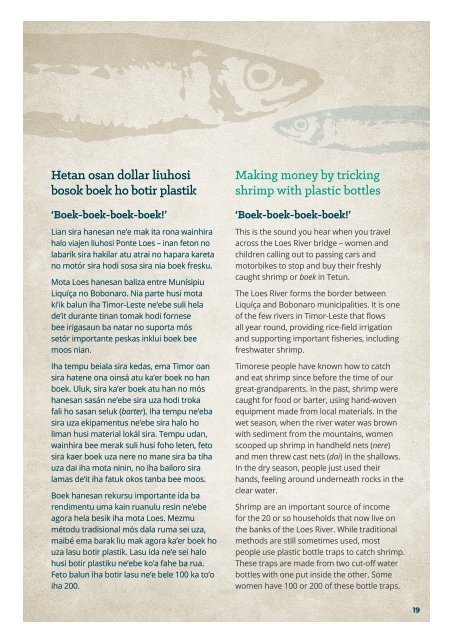Create successful ePaper yourself
Turn your PDF publications into a flip-book with our unique Google optimized e-Paper software.
Hetan osan dollar liuhosi<br />
bosok boek ho botir plastik<br />
‘Boek-boek-boek-boek!’<br />
Lian sira hanesan ne’e mak ita rona wainhira<br />
halo viajen liuhosi Ponte Loes – inan feton no<br />
labarik sira hakilar atu atrai no hapara kareta<br />
no motór sira hodi sosa sira nia boek fresku.<br />
Mota Loes hanesan baliza entre Munísipiu<br />
Liquíça no Bobonaro. Nia parte husi mota<br />
ki’ik balun iha Timor-<strong>Leste</strong> ne’ebe suli hela<br />
de’it durante tinan tomak hodi fornese<br />
bee irigasaun ba natar no suporta mós<br />
setór importante peskas inklui boek bee<br />
moos nian.<br />
Iha tempu beiala sira kedas, ema Timor oan<br />
sira hatene ona oinsá atu ka’er boek no han<br />
boek. Uluk, sira ka’er boek atu han no mós<br />
hanesan sasán ne’ebe sira uza hodi troka<br />
fali ho sasan seluk (barter). Iha tempu ne’eba<br />
sira uza ekipamentus ne’ebe sira halo ho<br />
liman husi material lokál sira. Tempu udan,<br />
wainhira bee merak suli husi foho leten, feto<br />
sira kaer boek uza nere no mane sira ba tiha<br />
uza dai iha mota ninin, no iha bailoro sira<br />
lamas de’it iha fatuk okos tanba bee moos.<br />
Boek hanesan rekursu importante ida ba<br />
rendimentu uma kain ruanulu resin ne’ebe<br />
agora hela besik iha mota Loes. Mezmu<br />
métodu tradisional mós dala ruma sei uza,<br />
maibé ema barak liu mak agora ka’er boek ho<br />
uza lasu botir plastik. Lasu ida ne’e sei halo<br />
husi botir plastiku ne’ebe ko’a fahe ba rua.<br />
Feto balun iha botir lasu ne’e bele 100 ka to’o<br />
iha 200.<br />
Making money by tricking<br />
shrimp with plastic bottles<br />
‘Boek-boek-boek-boek!’<br />
This is the sound you hear when you travel<br />
across the Loes River bridge – women and<br />
children calling out to passing cars and<br />
motorbikes to stop and buy their freshly<br />
caught shrimp or boek in Tetun.<br />
The Loes River forms the border between<br />
Liquíça and Bobonaro municipalities. It is one<br />
of the few rivers in Timor-<strong>Leste</strong> that flows<br />
all year round, providing rice-field irrigation<br />
and supporting important fisheries, including<br />
freshwater shrimp.<br />
Timorese people have known how to catch<br />
and eat shrimp since before the time of our<br />
great-grandparents. In the past, shrimp were<br />
caught for food or barter, using hand-woven<br />
equipment made from local materials. In the<br />
wet season, when the river water was brown<br />
with sediment from the mountains, women<br />
scooped up shrimp in handheld nets (nere)<br />
and men threw cast nets (dai) in the shallows.<br />
In the dry season, people just used their<br />
hands, feeling around underneath rocks in the<br />
clear water.<br />
Shrimp are an important source of income<br />
for the 20 or so households that now live on<br />
the banks of the Loes River. While traditional<br />
methods are still sometimes used, most<br />
people use plastic bottle traps to catch shrimp.<br />
These traps are made from two cut-off water<br />
bottles with one put inside the other. Some<br />
women have 100 or 200 of these bottle traps.<br />
19

















